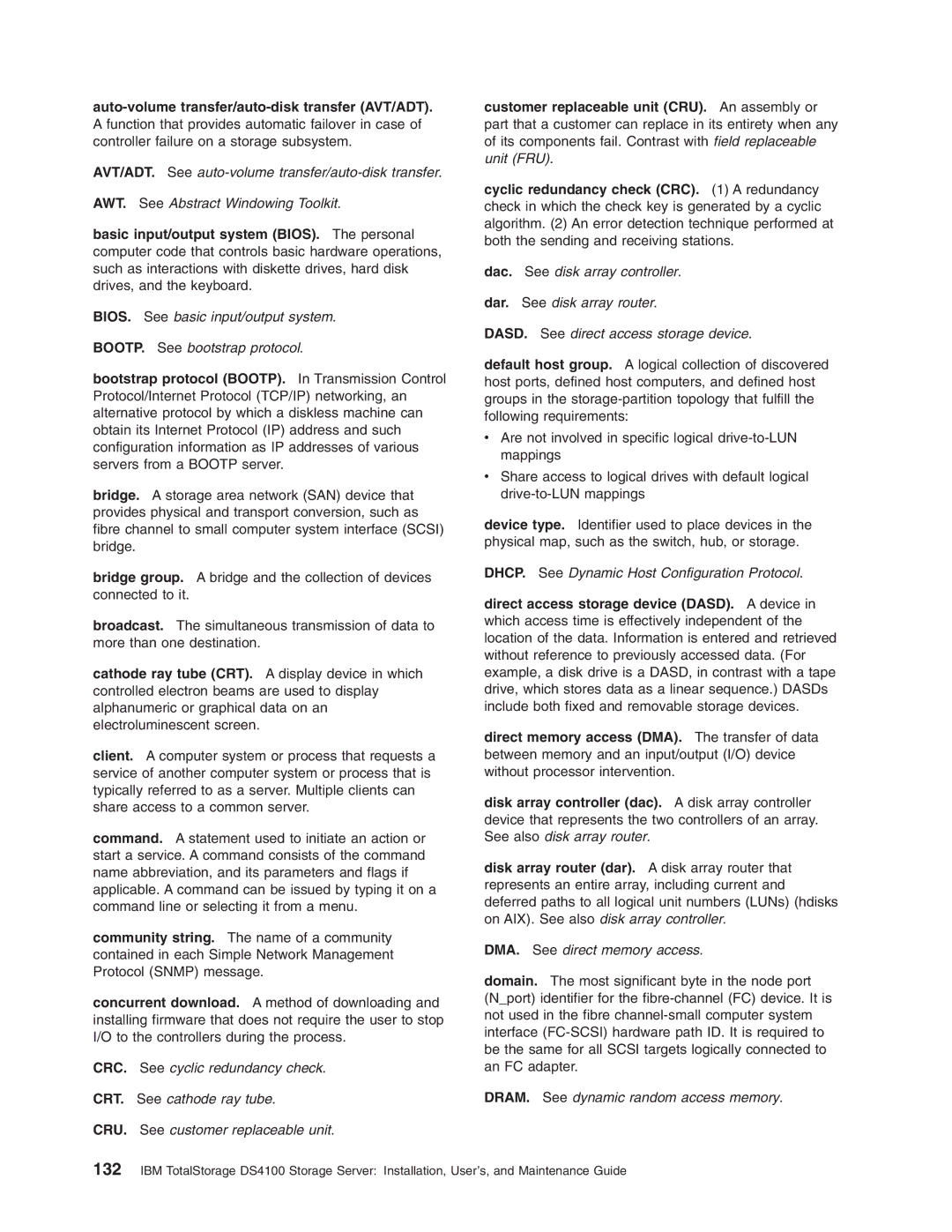auto-volume transfer/auto-disk transfer (AVT/ADT).
A function that provides automatic failover in case of controller failure on a storage subsystem.
AVT/ADT. See
AWT. See Abstract Windowing Toolkit.
basic input/output system (BIOS). The personal computer code that controls basic hardware operations, such as interactions with diskette drives, hard disk drives, and the keyboard.
BIOS. See basic input/output system.
BOOTP. See bootstrap protocol.
bootstrap protocol (BOOTP). In Transmission Control Protocol/Internet Protocol (TCP/IP) networking, an alternative protocol by which a diskless machine can obtain its Internet Protocol (IP) address and such configuration information as IP addresses of various servers from a BOOTP server.
bridge. A storage area network (SAN) device that provides physical and transport conversion, such as fibre channel to small computer system interface (SCSI) bridge.
bridge group. A bridge and the collection of devices connected to it.
broadcast. The simultaneous transmission of data to more than one destination.
cathode ray tube (CRT). A display device in which controlled electron beams are used to display alphanumeric or graphical data on an electroluminescent screen.
client. A computer system or process that requests a service of another computer system or process that is typically referred to as a server. Multiple clients can share access to a common server.
command. A statement used to initiate an action or start a service. A command consists of the command name abbreviation, and its parameters and flags if applicable. A command can be issued by typing it on a command line or selecting it from a menu.
community string. The name of a community contained in each Simple Network Management Protocol (SNMP) message.
concurrent download. A method of downloading and installing firmware that does not require the user to stop I/O to the controllers during the process.
CRC. See cyclic redundancy check.
CRT. See cathode ray tube.
CRU. See customer replaceable unit.
customer replaceable unit (CRU). An assembly or part that a customer can replace in its entirety when any of its components fail. Contrast with field replaceable unit (FRU).
cyclic redundancy check (CRC). (1) A redundancy check in which the check key is generated by a cyclic algorithm. (2) An error detection technique performed at both the sending and receiving stations.
dac. See disk array controller.
dar. See disk array router.
DASD. See direct access storage device.
default host group. A logical collection of discovered host ports, defined host computers, and defined host groups in the
vAre not involved in specific logical
vShare access to logical drives with default logical
device type. Identifier used to place devices in the physical map, such as the switch, hub, or storage.
DHCP. See Dynamic Host Configuration Protocol.
direct access storage device (DASD). A device in which access time is effectively independent of the location of the data. Information is entered and retrieved without reference to previously accessed data. (For example, a disk drive is a DASD, in contrast with a tape drive, which stores data as a linear sequence.) DASDs include both fixed and removable storage devices.
direct memory access (DMA). The transfer of data between memory and an input/output (I/O) device without processor intervention.
disk array controller (dac). A disk array controller device that represents the two controllers of an array. See also disk array router.
disk array router (dar). A disk array router that represents an entire array, including current and deferred paths to all logical unit numbers (LUNs) (hdisks on AIX). See also disk array controller.
DMA. See direct memory access.
domain. The most significant byte in the node port (N_port) identifier for the
DRAM. See dynamic random access memory.
132IBM TotalStorage DS4100 Storage Server: Installation, User’s, and Maintenance Guide
